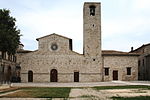Ascoli Piceno Baptistery
Ancient Roman templesBaptisteries in ItalyCatholic baptisteriesMedieval architectureRoman Catholic churches in Ascoli Piceno ... and 1 more
Romanesque architecture in Italy

The Ascoli Piceno Baptistery (Italian: Il battistero di San Giovanni di Ascoli Piceno), also known as the baptistery of Saint John, is a religious building found on the eastern end of the piazza Arringo at the center of Ascoli Piceno and sitting next to and just north of the cathedral dedicated to St. Emygdius, the city's patron saint. The structure, simple and austere in its architectural form, perfectly represents the Romanesque style in Ascoli, and, being ranked among the best examples of Italian works of art, is included in the list of Italian national monuments (r.d. n.7033 del 20/07/1890).
Excerpt from the Wikipedia article Ascoli Piceno Baptistery (License: CC BY-SA 3.0, Authors, Images).Ascoli Piceno Baptistery
Corso Trento e Trieste, Ascoli Piceno
Geographical coordinates (GPS) Address Nearby Places Show on map
Geographical coordinates (GPS)
| Latitude | Longitude |
|---|---|
| N 42.8537661 ° | E 13.5762911 ° |
Address
Corso Trento e Trieste 113
63100 Ascoli Piceno
Marche, Italy
Open on Google Maps









